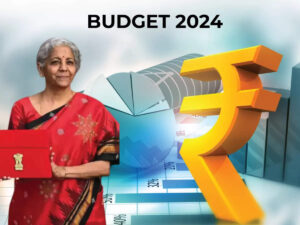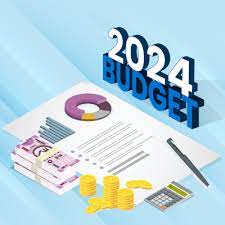Introduction
Budget 2024 : Presented annually by the Ministry of Finance The Union Budget of India is a critical financial statement. It outlines the government’s revenue and expenditure for the upcoming fiscal year and is a key instrument of economic policy. The Budget for the fiscal year 2024-25, presented by the Finance Minister on February 1, 2024, holds significant importance as it comes at a time of global economic uncertainties and domestic challenges. This detailed analysis explores the various aspects of India’s Budget 2024, including its objectives, key allocations, tax reforms, and sectoral impacts.

Objectives of Budget 2024
The Budget 2024 aims to address several key objectives to foster economic growth, improve infrastructure, enhance social welfare, and ensure fiscal prudence. The primary objectives include:
Economic Growth and Recovery : Boosting economic growth and recovery post-pandemic and amidst global economic slowdowns.
Job Creation and Employment : Focusing on job creation and reducing unemployment rates, especially in the wake of technological advancements and automation.
Infrastructure Development : Investing in infrastructure to enhance connectivity, logistics, and overall development.
Social Welfare and Inclusivity: Ensuring social welfare schemes are adequately funded to support marginalized and vulnerable populations.
Fiscal Discipline: Maintaining fiscal discipline to ensure a sustainable debt trajectory and managing the fiscal deficit.
Key Highlights and Allocations
Economic Growth and Recovery
To stimulate economic growth and recovery, the Budget 2024 has introduced several measures:
Increased Capital Expenditure: The government has allocated INR 10 lakh crore for capital expenditure, a significant increase from the previous year, to boost infrastructure projects, including roads, railways, and ports.
Support for MSMEs : The Micro, Small, and Medium Enterprises (MSMEs) sector receives a substantial allocation of INR 1.5 lakh crore, with specific schemes to improve access to credit and technology.
Industrial Growth : Incentives for the manufacturing sector, including tax benefits and ease of doing business measures, aim to boost industrial output and attract foreign investments.
Job Creation and Employment
The government has announced several initiatives to create jobs and reduce unemployment:
Skill Development Programs : An allocation of INR 25,000 crore for skill development programs to enhance the employability of the youth.
Rural Employment : The Mahatma Gandhi National Rural Employment Guarantee Act (MGNREGA) scheme receives a boost with INR 75,000 crore to ensure employment opportunities in rural areas.
Start-up Ecosystem : Support for start-ups and innovation with a dedicated fund of INR 10,000 crore to foster entrepreneurship and job creation.
Infrastructure Development
Significant investments in infrastructure are a cornerstone of Budget 2024:
National Infrastructure Pipeline (NIP) : The NIP continues to receive robust funding, with an allocation of INR 5 lakh crore for various projects, including highways, airports, and urban development.
Smart Cities Mission : INR 50,000 crore allocated to the Smart Cities Mission to promote sustainable and smart urban development.
Railways and Transport : A record allocation of INR 2.5 lakh crore for the Indian Railways to modernize and expand the railway network, enhance safety, and improve passenger amenities.
Social Welfare and Inclusivity
Ensuring social welfare and inclusivity remains a key focus :
Healthcare : INR 1.8 lakh crore allocated for healthcare, with emphasis on expanding healthcare infrastructure, improving primary healthcare, and enhancing the National Health Mission.
Education : The education sector sees an allocation of INR 1.2 lakh crore, focusing on digital education, improving school infrastructure, and promoting higher education.
Women and Child Development : INR 30,000 crore earmarked for schemes related to women and child development, including nutritional programs and maternal health initiatives.
Affordable Housing : The Pradhan Mantri Awas Yojana receives INR 40,000 crore to continue its mission of providing affordable housing to the urban and rural poor.
Fiscal Discipline
Maintaining fiscal discipline is crucial for sustainable economic growth:
Fiscal Deficit Target : The fiscal deficit target is set at 5.9% of GDP, with a roadmap to reduce it to below 4.5% by 2025.
Revenue Mobilization : Efforts to enhance revenue mobilization through better tax compliance and widening the tax base.
A sustainable debt-to-GDP ratio Public Debt Management : Strategies to manage public debt effectively and ensure.
Tax Reforms and Proposals
Direct Taxes
Several changes in direct taxes have been proposed to enhance compliance and provide relief to taxpayers:
Income Tax : The tax slabs for individuals have been revised, providing relief to middle-class taxpayers. The new tax regime includes lower tax rates and higher exemptions.
Corporate Tax : Reduction in corporate tax rates for MSMEs and start-ups to stimulate growth and encourage formalization of the economy.
Digital Economy : Introduction of a digital services tax to capture revenues from digital transactions and services provided by multinational companies operating in India.
Indirect Taxes
Changes in indirect taxes aim to streamline the tax structure and enhance ease of doing business:
Goods and Services Tax (GST) : Rationalization of GST rates for certain goods and services to simplify the tax structure and reduce compliance burden.
Customs Duty : Revision of customs duty on various items to promote domestic manufacturing and reduce dependency on imports.
Sectoral Impacts
Agriculture and Rural Development
Agriculture and rural development receive significant attention in Budget 2024:
Agricultural Infrastructure: INR 1 lakh crore allocated for agricultural infrastructure development, including irrigation, storage facilities, and logistics.
Farmers’ Welfare : Continuation of the PM-Kisan scheme with an allocation of INR 75,000 crore to provide direct income support to farmers.
Rural Development : INR 1.5 lakh crore for rural development programs aimed at improving rural infrastructure, sanitation, and connectivity.
Healthcare
The healthcare sector sees substantial investment to improve accessibility and quality:
Public Health Infrastructure : Expansion of public health infrastructure with a focus on primary and secondary healthcare facilities.
Medical Research : Increased funding for medical research and development to promote innovation and address emerging health challenges.
Health Insurance : Strengthening of the Ayushman Bharat scheme to provide health insurance coverage to the economically weaker sections.
Education
Education continues to be a priority with significant allocations and reforms:
Digital Education : Investment in digital education infrastructure to bridge the promote e-learning and digital divide.
Higher Education : Establishment of new universities and institutions of excellence to promote higher education and research.
Skill Development : Enhanced focus on vocational training and skill development to meet the demands of a rapidly changing job market.
Industry and Manufacturing
Support for industry and manufacturing is crucial for economic growth:
Make in India : Continued support for the Make in India initiative to reduce import dependency and promote domestic manufacturing.
Ease of Doing Business : Measures to simplify regulatory processes and improve the ease of doing business to attract foreign investment.
Technology and Innovation : Incentives for research and development in technology and innovation to position India as a global technology hub.
Energy and Environment
The energy and environment sectors receive focused attention:
Renewable Energy : Significant investment in renewable energy projects, including solar, wind, and hydroelectric power, to promote sustainable energy sources.
Climate Change : Allocation for climate change mitigation and adaptation programs to address environmental challenges and promote green initiatives.
Clean Energy : Promotion of clean energy technologies and reduction in carbon emissions to achieve India’s climate goals.
Challenges and Opportunities
Challenges
While the Budget 2024 is ambitious and comprehensive, it faces several challenges:
Global Economic Uncertainty : The global economic slowdown and geopolitical tensions pose risks to India’s economic recovery and growth.
Inflation : Rising inflation, particularly in food and fuel prices, could impact the cost of living and erode the purchasing power of consumers.
Fiscal Discipline : Maintaining fiscal discipline while ensuring adequate funding for social and infrastructure projects is a delicate balance.
Opportunities
Budget 2024 Despite the challenges, presents several opportunities:
Economic Diversification : The focus on various sectors, including agriculture, manufacturing, and services, provides opportunities for economic diversification and balanced growth.
Innovation and Technology : Investments in technology and innovation can position India as a global leader in emerging technologies.
Sustainable Development : The emphasis on renewable energy and environmental sustainability offers opportunities for green growth and sustainable development.
Conclusion
India’s Budget 2024 is a comprehensive financial statement aimed at fostering economic growth, creating jobs, improving infrastructure, and ensuring social welfare. The Budget addresses key challenges while presenting numerous opportunities for sustainable development and inclusive growth.
As the government implements the various proposals and allocations, the success of the Budget will depend on effective execution, stakeholder collaboration, and continued focus on the overall economic and social well-being of the nation.



